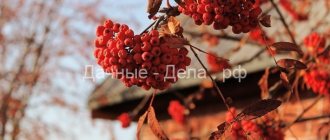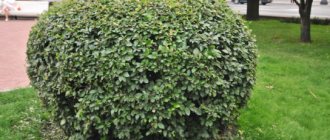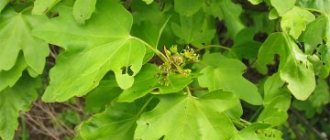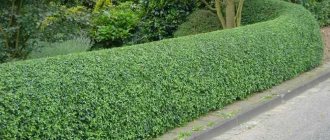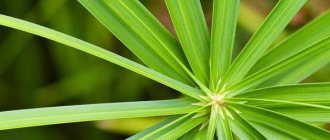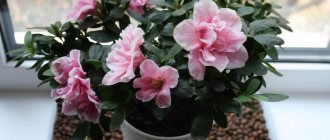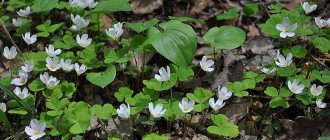Pine trees are among the oldest surviving conifers. The plant genus includes two subgenera: typical pines in the subgenus Pinus and white pines in the subgenus Strobus.
How long does a pine tree live? Most garden forms can live for more than a century, and in nature the age of some species is hundreds of years. The oldest pine trees, at least 4,000 years old, grow in the Ancient Bristlecone Pine Forest of California.
And the most ancient representative of the world of flora is a pine tree, 4800 years old, called “Methuselah” and growing on the slope of the White Mountains of this unique place.
Pines owe their enormous popularity among gardeners to their richness of decorative forms, low maintenance requirements and numerous possibilities for use in the garden. The rules for planting pine trees are no different from other conifers, and growing from seeds allows you to obtain new seedlings.
Description of pine
The sizes of representatives of the genus vary from one and a half meter dwarfs to real giants 60-80 meters high. The crown is usually conical, round or flat, umbrella-shaped.
Decorative spruce, care, varieties and photos
Modified leaves - needles are long, narrow, arranged in a spiral. The needles on the shoot are collected in bunches of 2-7 needles, which are connected at the base. Their color depends on the type or variety of crop. Pine needles remain on the tree for at least 2 years, after which they fall off, and young needles take their place.
Bloom
How does a pine tree bloom? The pollination process occurs through male and female cones rather than flowers, so the term "bloom" is used figuratively.
In spring, small, yellow or pinkish, elongated male cones-microstrobiles with pollen grains are formed at the tops of the shoots. When the pollen transfer process ends, they fall off.
Female cones are often located nearby and look more decorative. The pollen enters the female cone and the pollination process begins, which can last about a year. The ripening of the cones themselves with seeds takes two or three years.
Austrian black pine – pinus nigra
A tree 20–30 m high with a conical crown; older trees have a flat crown. The cones are collected in groups of 2–4, almost sessile, ovoid or somewhat elongated, 5–7.5 cm long and 2–3.5 cm wide, shiny, gray-brown, open in the third year and soon fall off.
Range: central and southern Europe. The most favorable conditions for this pine are Ukraine, the south of the European part of the Russian Federation, including the entire Crimea and the North Caucasus.
The most interesting forms in culture are:
- Pendula
– with hanging branches; - Pyramidata
- with ascending branches and a narrower crown; - Variegata
- with spotted yellowish-yellow needles; - Prostrata
is a creeping form with outstretched branches.
One of the most resin-bearing trees in Europe; The so-called Austrian turpentine is extracted from this pine. A close species is the Crimean pine ( Pinus Pallasiana
).
Varieties and types of pine with photos
Weymouth pine (Pinus strobus) . The height of decorative forms varies from 7 to 15 m. The needle-like foliage is long and soft. Young trees have a conical crown, which becomes asymmetrical as they grow.
Spectacular varieties are the Pendula shaped varieties with weeping long branches and very fine light green needles, such as 'Angel Falls' or 'Niagara Falls'.
"Niagara Falls"
Another well-known variety of this species is the Fastigiata pine with a beautiful, dense, egg-shaped crown. Long, soft needles of a beautiful bluish shade.
"Fastigiata"
Heldreich's pine or Bosnian pine (Pinus heldreichii) is a species found in the southern and western Balkans, near the Mediterranean basin. The tree is frost-resistant, shows low susceptibility to insect attacks and is able to adapt to extreme environmental conditions.
Varieties of the species
Pine "Compact Jam" is a dwarf tree with a conical, neat crown. The needles are dark green. After 10 years of cultivation, it grows up to 1.2 m in width and up to 2 m in height. Prefers full sun, grows well on poor substrates, and is drought-resistant.
"Compact Jam"
Geldreich's pine "Malinki" is a variety with a wide, dense crown. The height of an adult tree is approximately one and a half meters, width - 1 meter. Seasonal growth is 10-15 cm.
"Malinki"
Italian pine or pine (P. Pinea) . Fine Mediterranean pine trees with a broad spherical or flat top when mature. A low variety of this type of pine, “Silver Cross,” which is often grown in pots, is popular among gardeners.
"Silver-Crest"
Dwarf pine, synonym – dwarf cedar (Pinus pumila) . The coniferous plant comes from Mongolia, Transbaikalia and the Southern Kuril Islands, where it grows on mountain slopes at an altitude of 1000 to 2300 m above sea level. The height of a coniferous plant in its natural habitat is 1-3 meters.
The shoots are spreading, creeping, the crown is asymmetrical. Depending on the surrounding conditions, it may look like a shrub or tree. It grows very slowly and can live 300 or even 1000 years. The needles are collected in bunches of 5 pieces, slightly bluish. The cones are small, red-brown or purple.
Dwarf pine is completely unpretentious in care and grows well on almost any soil, even dry sandy or loamy soil. It does not freeze, is rarely affected by diseases, and can grow in both sun and partial shade.
Varieties of the species
Pine "Glauca" is a varietal form of this species 2-3 meters high with bluish-silver needles. Received an award from the Royal Horticultural Society.
"Glauca"
"BLUE DWARF" is a dwarf form with carmine-red cones and blue needles.
"Blue Dwarf"
Mountain Mugus or European pine (P. mugo) . The height of the plant does not exceed 3 m, the trunk is strong and short. Needle-shaped leaves are naturally green in color and hard. Young buds are purple-red.
Can be grown on sandy, gravel, poor substrate, regardless of pH. The species is also very resistant to severe frosts, tolerates drought and strong winds. A variety of this species is the mountain pine Mugo Mugos (P. mugo var. Mughus).
In gardens you can find numerous varieties of P. mugo with high ornamental qualities. Variants of dwarf mountain pine are especially in demand in gardening.
Mountain pine varieties
Mountain pine “Pug” is a dwarf variety of regular spherical shape with emerald, short needles. Winter-hardy, drought-resistant, light-loving, low requirements for soil and moisture.
"Pug"
Mountain pine "Varella" is a spectacular hedgehog bush with a dense, spherical crown. The ten-year-old plant reaches only about 70 cm in height, while the height of older specimens is one and a half meters. The needles are wavy, tender, bright green.
Varella variety
Mountain pine "Pumilio" (Pinus pumila). The Pumilio varietal series unites a group of low-growing shrubs. It lends itself well to formative pruning and can be used as a ground cover.
Pinus pumila
Mountain pine "Winter Gold". A low-growing variety 1-2 m high. The seasonal color of the needles is green with a yellow tint. In spring, the needles are almost light green, and in winter they turn golden.
"Winter Gold"
Pine "Gnome" of this type. It is a tree with a dense, dark green, rounded crown. The height of an adult variety is approximately 2-3 meters. It grows very slowly. Height can be successfully controlled by pruning or pinching. Ideal for bonsai shaping.
Variety "Gnome" in bonsai style
Japanese white pine, synonym - small-flowered pine (Pinus parviflora) , grows naturally in Korea and Japan. The height of the tree is approximately 15-20 meters, the shape of the crown is wide, conical. The needles are collected in bunches of 5-6 needles. This popular tree is in demand in bonsai art and landscape design.
Varieties
"Miyajima" is a dwarf variant with a dense, spherical crown when young and bluish-gray needles. The tree was first discovered on the island of Miyajima almost 400 years ago and has been extremely popular ever since.
"Miyajima"
Pine parviflora "Negishi" is another very old cultivar, 1.8 to 2.5 meters tall with beautiful silver-green needles. Due to its relatively short needles, durability and good tolerance to shaping haircuts, the variety is used in the art of bonsai.
"Negishi"
"Ogon Janome" - An incredibly beautiful plant. This rare, medium-tall form of Japanese pine exhibits variegated needles with yellow stripes on the needles.
"Ogon Janome"
'TANIMA NO YUKI' is a dwarf variety with very slow growth and lush creamy white needles.
"TANIMA NO YUKI"
Himalayan pine or Griffith pine (Pinus wallichiana) , in nature it can be found in valleys and on sunny mountain slopes. Its crown resembles a wide cone with spreading branches, shoots branching from the ground itself. In nature it grows up to 25-50 m.
Unusual beauty, soft hanging needles, collected in bunches of 5 pieces, reach a length of 20 cm. Their color is bluish or green, and bluish on young trees. The cones are narrow, long, curved.
Varieties of Himalayan pine
“Nana” is a dwarf pine, the height of which is 2-2.5 meters, the needles are thin, blue-gray.
"Nana"
"Zebrina" - bluish needles with yellow transverse stripes.
Black pine nigra (Pinus nigra) , sometimes called Austrian pine. Native to the Mediterranean regions and Asia Minor. It grows quite quickly, reaching a height of 50 m.
Pine nigra "Pyramidalis" (Pyramidalis) - the variety grows quite quickly. The shape is columnar with vertical shoots; upon reaching maturity, the height of the tree is 6 meters.
"Pyramidalis"
The black pine variety "Nana" with a spherical crown is characterized by a very slow growth rate and even after 30 years reaches only 3 m in height. An exclusively decorative option that has no special requirements.
Scots pine (Pinus sylvestris) - in nature it can reach up to 40 m in height, but low-growing forms of this species are grown in gardens, for example, the 1.5 m high pine Globosa Viridis. It can be grown on a trunk. This variety is completely frost-resistant, making it suitable for planting in cold areas.
"Globosa viridis"
Another popular variety of Scots pine is “Watereri”, up to 4 m in height. The crown is spherical, the needles are gray, slightly twisted.
"Vatereri"
general information
Decorative pine most often refers to dwarf, spherical and pyramidal varieties, which are good for growing in pots and flowerpots, small flower beds and rockeries, and bonsai art. However, in a broader sense, it is any tree that serves to decorate a site. Even forest pine can be refined so that it looks no worse than selective and expensive species. The main advantages of this tree:
- variety of varieties;
- evergreens - decorate the garden at any time of the year;
- longevity;
- unpretentiousness;
- frost resistance.
This description can be supplemented with versatility: decorative pine almost always acts as the basis of the entire garden composition. It does not require any auxiliary decoration, it loves well-lit places, but it should not be exposed to direct sunlight.
How to plant a pine tree
The tree feels comfortable in all types of soil. Even rocky and sandy areas of the garden will be favorable for its growth.
The anchor rod system of the root allows you to obtain the necessary moisture at a fairly large depth underground.
However, the pH level of the soil is a fairly important factor in growing pine in the garden. A low level indicates acidic soil, and a high level indicates alkaline soil.
Most species and varieties prefer neutral or slightly acidic soil. If the soil is alkaline, you can acidify it with peat or sphagnum moss.
When choosing a place to plant a pine tree, be sure to consider the lighting. Coniferous trees love sunny places or light partial shade.
Saplings with an open root system are planted in a dormant state - in November or early spring. Trees in containers can be planted throughout the season, but avoid the procedure on hot and dry days.
Dig a planting hole larger than the root ball. At the bottom, lay a drainage layer of broken brick or large expanded clay, then fill the lower part of the hole with the top layer of fertile soil taken from the planting hole.
Spring planting of trees and shrubs
Place the seedling and cover with the remaining soil. The root collar after planting should be at ground level or slightly higher. Firm the soil around the seedling and water well. Do not allow the soil to dry out during the first year of growing pine trees. It is advisable to tie trees on a trunk to a support until they become stronger.
It is recommended to mulch the tree trunk area around the seedlings with a layer of peat, pine needles or wood chips, but so that the mulch does not touch the trunk. The procedure protects the soil from drying out, suppresses the growth of weeds and, by decaying, provides the plant with nutrients.
Wintering pine trees on the site
Autumn care rules
All types of pine are frost-resistant, with the exception of Thunberg pine. After it gets colder outside, all processes in the plant slow down, but they do not stop completely. In this regard, pine trees need to be prepared for wintering. Approximately in the last days of November, before severe frosts begin, it will be necessary to carry out moisture-recharging irrigation. If the height of the tree is less than 100 cm, then 20 liters of water need to be poured under it; for taller specimens, the consumption rate increases to 30–50 liters. Before watering, it is necessary to make an earthen dump along the perimeter of the tree trunk circle, this will prevent the liquid from spreading over the area. In one-year and two-year-old seedlings, the root system is still underdeveloped, so moisture-recharging watering in the autumn is especially important for them. It is also simply necessary for plants that have undergone formative pruning this season, and for varieties and forms characterized by low frost resistance.
With the onset of August, it is forbidden to apply fertilizers containing nitrogen to the soil, because it helps stimulate the growth of green mass. And in the autumn, it is necessary for the existing shoots to grow and ripen, otherwise they will die in the winter. In order for them to become lignified faster, in September they are fertilized with phosphorus-potassium fertilizer; this will also help make the plant’s root system stronger.
When preparing young specimens for wintering, you must remember to cover the surface of the tree trunk circle with a layer of mulch. Experts recommend mulching the soil with tree bark, which needs to be crushed. The fact is that such mulch allows air to pass through, which is necessary for the root system, and during a thaw, evaporation also does not linger in the soil, this helps prevent the root collar or roots of the plant from rotting, which happens quite often if the soil is covered with sawdust.
Conifers. Preparing for winter.
Wintering
If there is heavy snowfall in winter, then due to heavy wet snow, thin branches may be injured, and fractures may also appear on skeletal branches. It is prohibited to pull a pine tree by its branches or shake it in winter, because during this period it is very fragile, and even a little effort can cause cracks to appear on the branches. You can remove snow from branches that you can reach by using a brush or a broom with a long handle, moving from the tip of the branch to the trunk. To remove snow from branches growing relatively high, you need to use a long stick or board, wrap one of its ends with cloth, then use it to hook the required branch, which should be swung up and down. Faults can also form due to an ice crust that appears on the plant during a thaw or when the temperature is above zero during the daytime and below zero at night. To prevent injury to the branches, it is necessary to place supports under them, as is done with fruit crops during the formation of a large number of fruits.
varieties of pine trees. how to choose pine trees in a nursery. How not to make a mistake in choosing pine
Conditions for growing pine
Pines are undemanding in care, they tolerate low temperatures well and are resistant to drought. Only Himalayan varieties need to mulch the soil with a thick layer of fallen leaves or spruce branches in winter to protect the roots.
Pinus strobus Pendula
Watering pine trees . Water requirements depend on factors such as weather, soil, light and the presence of mulch. Typically, pine trees only need watering during periods of prolonged absence of rain.
Sandy soils lose moisture faster than loams. In bright sunshine, moisture also evaporates faster, but mulch prevents water loss.
Lack of sun and constant soil moisture have a negative impact on pine growing. In a too dark area of the garden, coniferous beauties quickly lose their attractiveness, the needles become thinner, and the color fades. Excess moisture leads to the development of fungal diseases.
Feeding of coniferous trees begins in the second year of life. Feed a couple of times a season with small doses of slowly soluble balanced fertilizers (nitrogen, potassium and phosphorus). On fertile substrates, plantings are fed once per growing season.
Pine pruning is tolerated well, although the procedure is rarely required due to the decorative shape of the varieties. However, to limit tree growth or increase crown density, new shoots can be cut back by half in late spring.
Which plants to choose for forming topiary figures
Sanitary pruning is necessary for all varietal forms: in early spring, diseased, damaged and dried branches are removed.
Use of plants in landscape design
Tall ornamental pines are most often used for:
- landscaping of megacities;
- decoration of large areas;
- creating alleys;
- figures of park art;
- formation of floral arrays.
The use of low-growing varieties in landscape design is more diverse:
- small gardens;
- sekitei - Japanese rock garden;
- lawn background;
- mini flower arrangements;
- Moorish lawn;
- growing in pots, cache-pots, flowerpots, containers;
- roof decoration;
- hedges;
- mixborders;
- bonsai;
- rock gardens, rockeries, alpine slides.
Pyramid ones are good for decorating entrances and entrances. Ball-shaped ones are used to decorate the patio. Creeping ones look great in flower beds. In addition, any varieties can be planted on the site for a practical purpose - to strengthen the slopes and retain snow.
How to open pine cones at home
The cones are collected while still immature, unopened. Place in a shallow dish and cover with a regular sifter to prevent birds from pecking the seeds.
Unripe buds
The buds should remain dry throughout the ripening period, as this will speed up the time required for the scales to open. After about a week, the cones fully ripen, darken and open.
Pine seeds
The seeds fall out on their own.
Overview of varieties
A table describing some varieties will help you choose the appropriate option.
Low-growing varieties (up to 3 m in maximum height)
Medium height (from 3 to 10 m)
Tall (above 10 m)
It is impossible to describe all varieties of decorative pine, since there are a huge number of them. Due to the great demand for this tree in landscape design, breeders do not get tired of creating more and more new species.
How to grow pine from seeds at home
Pine propagation is carried out using seeds. First of all, it is necessary to separate empty and viable seeds. The material is filled with water and left for 24 hours. After this time, empty seeds will remain on the surface of the water, and ready-to-germinate seeds will sink to the bottom.
Before planting in the ground, the seed must undergo cold stratification. The seeds are placed in a plastic bag with damp sphagnum moss or a damp paper napkin and stored in the refrigerator for 3-4 weeks at a temperature of 2-5 °C.
Seed stratification
If a few minutes after placing it in the refrigerator the bag fogs up from the inside, it means there is enough moisture in it.
Sow in a mixture of equal parts of peat moss, sand and vermiculite to a depth of 1 cm, moisten with a weak solution of potassium permanganate using a spray bottle and cover with film. The container is kept in diffused sunlight and the substrate is kept moist.
After emergence of shoots, the film is removed.
Pine seedlings
Watering is carried out after the top layer of soil has dried. Grown seedlings dive into separate pots with fertile soil. They are planted in open ground at the end of spring and are well insulated during the first winter.
Mr. Summer resident recommends: medicinal properties of pine
With a detailed study of pine, it becomes clear why healthcare facilities and sanatoriums have pine trees. They are great for air disinfection. Pine needles are a kind of multivitamin that contains a whole list of substances beneficial to humans.
In folk medicine, pine is used to combat diseases such as osteochondrosis, rheumatism, and cardiovascular diseases. The essential oil, which can be extracted from the tree, is used to treat colds, pain and redness of the throat, and shows excellent results in psychotherapy.
Pine diseases
Schutte is a group of fungal diseases of conifers. A common symptom of infection is the appearance of spots, yellowing and/or premature shedding of the needles. The diseases have somewhat similar symptoms, but treatments may differ.
How to get rid of aphids using folk remedies
At the end of spring and until autumn, the fungus can infect young seedlings. Often the first symptoms are visible in September - yellow lines appear on the needles. In autumn and winter, the leaves turn brown with black spots. The following spring, most of the infected needles fall off. Treatment is carried out by treating with fungicides such as Ditan, Neotek, Amistar.
Schutte disease
Red spotting of needles. A fungal disease is manifested by the appearance of red-brown stripes on the needles. The tips of the needles first become light yellow, then all the needles darken and fall off.
The infection usually appears on the lower branches and, without treatment, spreads throughout the tree. Preventive treatment with copper fungicides 1-2 times a year reduces the risk of developing the disease.
Another dangerous disease is rust, which is characterized by the appearance of orange and yellow spots and ulcers with spores on the bark or needles. Without treatment with preparations containing copper, rust can lead to the death of shoots and death of the tree. The development of the disease is facilitated by planting pine trees next to currants and pears.
Diplodia is a fungal disease that affects the bark, needles and cones of a tree. Small black spots containing fungal spores appear and spread on rainy days, leading to necrosis and yellowing of the affected areas. Treated with a systemic fungicide.
Diplodia necrosis
Fusarium is a very dangerous disease of conifers. The first symptom of this disease is inhibition of plant growth and gradual withering and drying of shoots.
The disease is difficult to stop and all measures should be aimed at preventive treatment with Previkur Energy fungicide. A heavily infected tree should be burned.
Fusarium
Gray mold. Watery, brown spots on the needles increase over time, leading to the death of needles and shoots. Constant dampness causes a gray coating to appear. The disease attacks mainly young seedlings in dense plantings with high air and soil humidity.
Caring for pine trees with signs of infection with any diseases comes down to treating them with appropriate preparations and removing diseased parts of the tree. Planting trees with sufficient air circulation around the seedling, proper watering and a sunny position is an excellent disease prevention.
Growing heather in the garden
Increases plant immunity and resistance to adverse conditions with mycorrhiza (symbiotic fungal vaccine), which is introduced into the soil near the roots.
Care
Despite its unpretentiousness, decorative pine still requires attention and care. Potted varieties are watered daily, unlike those trees that grow in open ground - their watering depends on rain, but on average it is twice a week.
Feeding is carried out from the second year of life, obligatory - in the spring, unscheduled - in case of illness. It is better to buy fertilizers specifically designed for conifers. Manure should not be used, and nitrogen compositions should be limited as much as possible.
How to feed decorative pine in spring:
- vermicompost;
- rotted compost;
- potassium-phosphorus complex fertilizers;
- biostimulants Epin or Zircon (necessarily in early spring);
- phytohormones (Heteroauxin or Kornevin).
In the fall, you can add a small amount of magnesium sulfate or rooting agents to the soil. Mandatory care also includes mulching (sawdust, straw, peat, crushed cones, shredded bark), pruning (sanitary - in the spring, therapeutic - in case of illness, shaping - throughout the season), before winter - covering dwarf species and tying up tall ones. And also do not forget to shake the snow off the branches so that they do not break off under its weight.
Pine pests
Pests include bark beetles and sawflies, which damage and weaken the plant and make it susceptible to disease.
Yellowish-brown, skeletonized needles are an early sign of sawfly infestation. Later they fall off. Bark beetles and sawflies are destroyed using pyrethroid drugs.
Sawfly larvae
No less dangerous are the caterpillars of the silkworm butterfly, the larvae of the pine hawkmoth, and the pine cutworm. Pine trees are often affected by brown aphids, scale insects and pine hermes.
Aphids on pine needles
The dots, which look like small splashes of white paint on the needles, are the winter shelter of the pine scale insect.
Scale insect shelters
You can get rid of pests using insecticides (Aktara, Calypso, etc.).
Why does the pine tree on the site turn yellow?
Periodically, the old inner needles turn yellow and fall off, and new ones appear in their place - this is the natural cycle of needle development. But sometimes, due to diseases or errors in caring for pine, you can notice yellowing of the foliage, which is not associated with the natural growth of the tree.
Prolonged drought, excessive moisture and poor soil permeability are additional stress factors that can contribute to yellowing. The reason may also be the lack of sunlight - if the sun does not reach the shoots, this leads to yellowing and falling of the needles.
Yellowing of needles
Winter yellowing of pine occurs when the plant's roots are unable to absorb enough water from the soil, causing the needles to begin to lose more moisture from the needles.
If a pine tree turns yellow in the fall and its needles fall off, then most likely the cause of the problem is pests and diseases, which gradually over the course of the season led to the death of the needles. The provoking factor is often a rainy and damp summer.
Why do the lower branches of a pine tree die? Lack of moisture can lead to the death of foliage, especially along the oldest branches, as well as drying out of old lower shoots. Dead lower branches on pine trees are sometimes symptoms of the late stage fungal disease diplodia.
Decorative pine for the garden
Pine has become widespread in landscape design due to its unpretentiousness and variety of decorative forms, which allow the evergreen beauty to harmoniously fit into the composition of any garden. In late autumn, winter and early spring, pine trees become the most important element of any landscape.
Dwarf varieties are used to decorate rockeries, rock gardens, and in group plantings with decorative deciduous shrubs and bright seasonal flowers.
Variety "Albospicata"
Medium-sized cultivars are good for creating a smooth visual transition from ground cover planes to tall shrubs and trees in the garden. They are magnificent in composition with heathers, hydrangeas, azaleas and rhododendrons.
In mixed plantings, pine trees look impressive next to larch, fir, maple, etc. Conifers are also interesting in multi-layered groups in combination with juniper, barberry, spirea and ground cover perennials.
Tall beauties serve as an accent to any landscape. There are varieties that are ideal for planting on slopes, such as Pumilio pine in hilly landscaping or the Hillside Creeper variety.
Advantages and disadvantages
The main advantage of cultivating pine in a summer cottage is its high decorative value. The shape of the crown can be pyramidal, openwork, ovoid, spreading, creeping, umbrella-like. The needles, depending on the variety, are painted in various shades of green and have a gray or bluish color. The length and shape of the needles also change. Proper pruning can significantly enhance the decorative effect.
The crop can take root in almost any area; many varieties are unpretentious to the structure and composition of the soil, so they grow and develop well on sandstones, loams, and rocky soils. This property is explained by the fact that in nature it is difficult for pine to compete with other species; it is often forced out into conditions where the others are not able to survive.
Care for a young seedling requires only the first 2-3 years, then it is gradually reduced to a minimum - moisture-recharging watering in the fall, sanitary pruning, protection from pests and diseases. Coniferous trees tolerate sudden changes in temperature, winter frosts, snowfalls, and recurrent spring frosts. It is advisable to protect against them only in the first year.
Pine releases phytoncides into the air, clearing the area of pathogens. These substances have a beneficial effect on human health. The pleasant resinous aroma acts as aromatherapy, calming the nervous system, improving sleep quality, helping to cope with stress and fatigue.
Over time, the pine tree trunk becomes covered with a thick layer of needles. This feature is not only a minus, but also a plus of growing pine on a personal plot. Fallen pine needles are a good mulch for other plants, protect the root system from freezing in winter, and help in the fight against some pests - mole crickets, slugs, wireworms. Needles are often used to produce organic fertilizers suitable for many crops and improve soil structure.
Fallen pine needles are a good mulch for other plants.
The main disadvantages of placing pine on the site:
- sensitivity to air quality, many species cannot tolerate smoke and gas pollution in large cities;
- tall species provide large shade, preventing the growth of other plants in the tree trunk circle and nearby;
- a powerful root system can destroy the foundations of nearby buildings;
- susceptibility to attack by pests, in some cases it is necessary to cut down the tree;
- high cost of seedlings.
